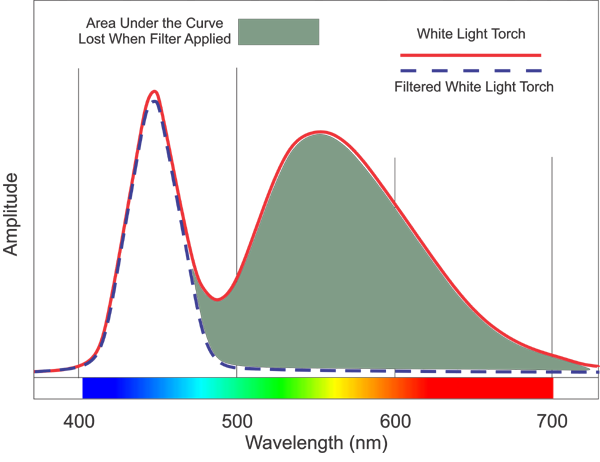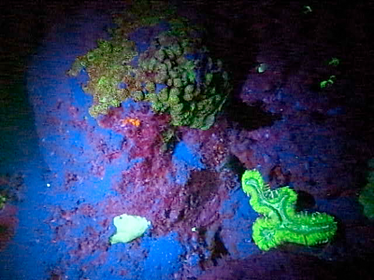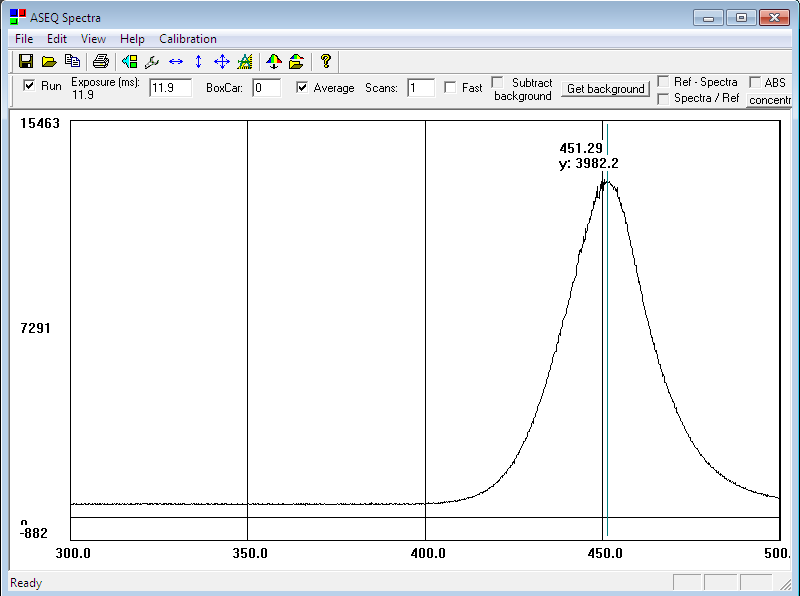A dichroic filter, or interference filter, is a very accurate color filter used to selectively pass light of a small range of colors while reflecting all other colors.
Dichroic filters use the principle of thin-film interference, and produce colors in the same way as oil films on water. When light strikes an oil film at an angle, some of the light is reflected from the top surface of the oil, and some is reflected from the bottom surface where it is in contact with the water. Because the light reflecting from the bottom travels a slightly longer path, some light wavelengths are reinforced by this delay, while others tend to be canceled, producing the colors seen.
For a very detailed discussion as to why it is ill advised to use an excitation filter over a white light torch, see the following document:
The above image is basically a summary of the referenced White Paper. The red waveform is the measured output spectrum of an actual white light dive torch. The blue dashed line is that same torch with an excitation filter in place on the torch front lens. The light green area under the red curve is the integral or the area under the curve that is lost output intensity when the filter is applied. This lost output represents nearly 80% of the total output of the torch. What is the take-away of this figure? Putting an excitation filter on a white light torch will indeed give you blue excitation light – it will just have about 20% of the power (what you see as brightness) as a dedicated blue light torch with an excitation filter.
The following discussion was prepared to answer the question as to what the real observable effect is with and without the use of an excitation filter. Many people ask: “If I have a torch with blue LED’s, do I really need a blue excitation filter on top of that; what does it actually do for me for the extra cost?”
This report should lay this issue to rest.
Note that the images are individual frame shots (snapshots) taken from low resolution video. Unfortunately due to a problem with the auto-focus of the camera, these images are all a bit blurred. The quality of these pictures is therefore rather poor.
For the purpose of this discussion however they are fine because all we are really looking for is the overall difference in color saturation and spectrum content.

Photo © 2013 Lynn Miner
The photo above shows an anemone during the daytime with red color at a depth (about 16 meters or 50 feet) at which red is already almost completely absent. This red color must therefore be the result of fluorescence of the anemone. This is the only exception to the rule that you need special lights and filters to observe fluorescence under water.
Details:
The images shown below were taken on 16 September 2012 at Roman Rock, Mashraba, Dahab, Egypt (Red Sea).
The light source was a 21 blue LED torch with an excitation filter mounted to the front such that it could be easily removed and replaced during the filming sequence.
Comparison
What follows are side by side comparisons of the same coral blocks unfiltered and filtered. To the extent possible all other things (angle of incidence, framing, position, etc.) were all kept the same. Notice the richness of the colors with the filter and the clear presence of more red in the images. Without the filter, the images appear “washed out” with very little brilliance and color saturation.
One can clearly see the dramatic difference in the overall aesthetic quality of the color in the filtered images. All our torches can be ordered with or without the filter, but based on the above discussion, we obviously recommend the filter be part of your fluorescence dive kit.
Spectrographs
The following images corroborate the above difference between a blue light with and without excitation filter in terms of spectrographs:
Sandwiched Strobe Filters
The following images demonstrate the difference between a sandwiched excitation filter from a different manufacturer (left) and our sandwiched excitation filters (right). These filters are designed for strobes only. A detailed discussion of why it’s a bad idea to use this type of filter on a white light torch can be found here: White Paper on Why a Dedicated Blue Light Source is better than a White Light Source with an Excitation Filter for Fluorescence Night Diving. Clearly our filters show more of the subtle details of fluorescence (e.g. the finer details of the arrowcrab, the faint red fluorescence of the background) and provide for less distortions. The last image at the bottom left has been taken with just a plain dichroic filter in front of the strobe instead of the sandwiched excitation filter from the other manufacturer. Note the white light which illuminates the background. This is a clear indication of the benefit of a sandwiched excitation filter over just a dichroic filter. All of the pictures below were taken by Solomon Baksh (used with kind permission).
Mixing Equipment From Different Vendors
All the photos on the left below were taken with a Nikon D7000, 60mm lens and two Sea&Sea YS110a strobes, using a FireDiveGear.com SuperBlue (discontinued) light for focusing, another vendor’s excitation filters on the strobes, and a FireDiveGear.com barrier filter on the lens.
All the photos on the right below were taken with a Nikon D7000, Sigma 17-70 lens and two Sea&Sea YS-D1 strobes, using a FireDiveGear.com SuperBlue (discontinued) light for focusing, FireDiveGear.com sandwich excitation filters on the strobes, and a FireDiveGear.com barrier filter on the lens.
This demonstrates that excitation and barrier filters (or torches and barrier filters) from different manufacturers do not always give the expected results. Every manufacturer has a system of torches and filters which complement and match each others properties. Mixing equipment from different manufacturers may therefore give suboptimal or even frustrating results.
All pictures were taken by Brian McHugh (used with kind permission).



